Introducing $PARTI: Chain Abstraction’s Economic Powerhouse
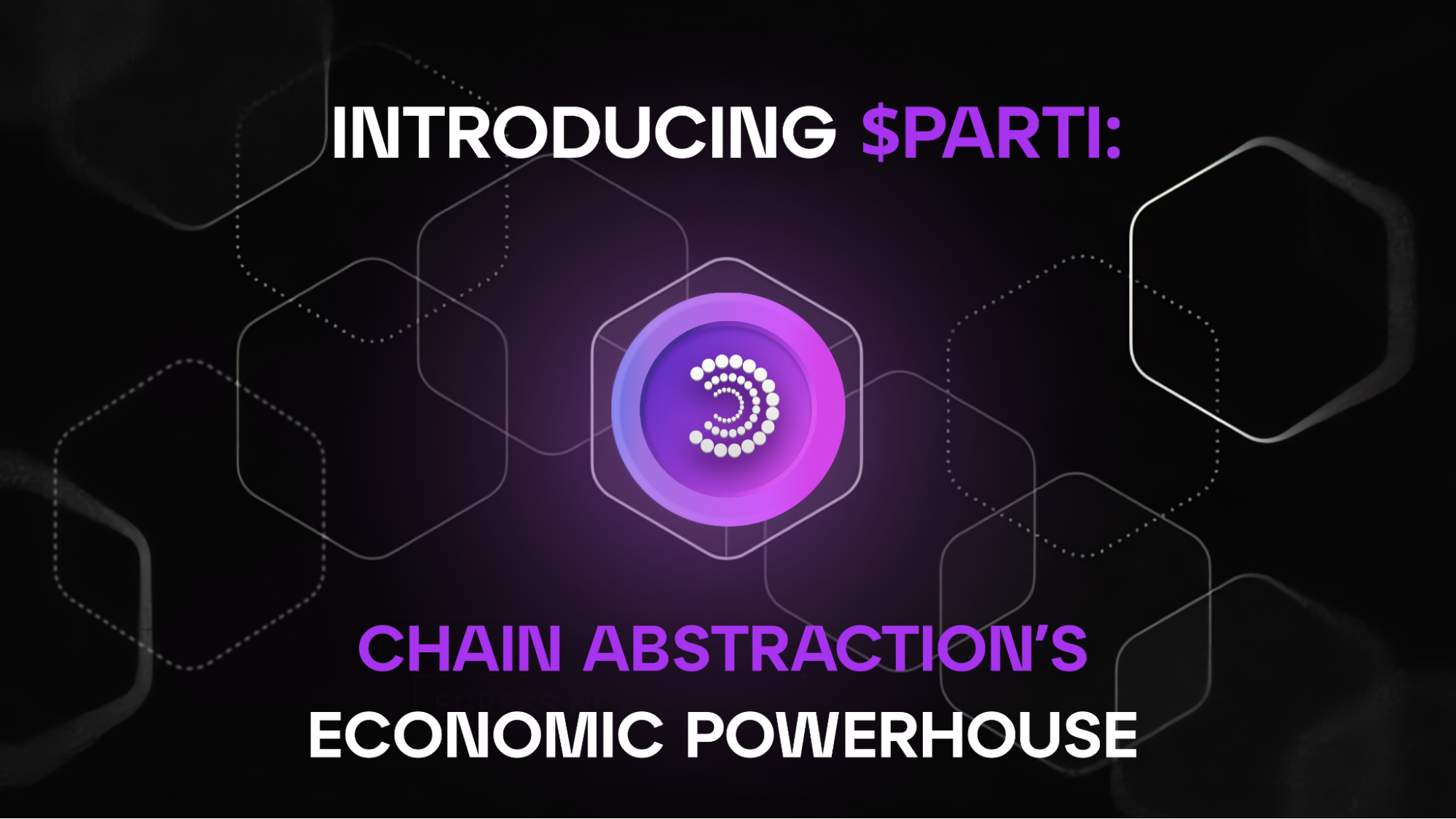
Table of Contents:
And just like that, $PARTI is now in the hands of our community.
In just a few months, we:
- Turned chain abstraction into one of the top narratives in Web3, driven by the necessity to unify its users and liquidity.
- Built a community around this vision.
- Took our flagship chain abstraction product, Universal Accounts, powered by the Particle Chain into Mainnet—making chain abstraction a reality.
- Launched the first chain-abstracted Mainnet dApp, UniversalX, showcasing the power of Universal Accounts and proving their Product-Market Fit.
- Released $PARTI into the world, with a staggering $1.26M raised on a 160x oversubscribed Binance IDO, and airdropping 9% of our total supply to our loyal community.
But as always, we choose to take every new step as a starting line.
With $PARTI out, the road toward fully decentralizing and growing our chain abstraction infrastructure—powered by our L1 blockchain, the Particle Chain—begins. This vision is driven by an economic and ecosystem design built around a simple, yet powerful goal: to accrue value for all ecosystem stakeholders as Universal Accounts unify Web3’s users and liquidity.
This article will detail how $PARTI acts as the economic powerhouse to align incentives for all participants and capture the value generated by chain abstraction’s expansion. We’ll also detail some of our future steps as Web3 enters a new Era.
$PARTI’s Role in the Particle Ecosystem
There are three core elements to our vision of a unified Web3 ecosystem:
- The Particle Chain, economically powered by $PARTI. The Particle Chain coordinates Universal Accounts’ activities across all chains, and is therefore a pillar of chain abstraction for the entire ecosystem.
- Universal Accounts (UAs), giving users the experience of one account, one balance, any chain. $PARTI acts as the key link between UAs and the Particle Chain, settling all transactions and capturing the value created by the chain-abstracted ecosystem. Driving all settlements on the Particle Chain, $PARTI is consumed (without the need for users to hold it) by every UA transaction.
- The ecosystem of dApps leveraging Universal Accounts. This will initially involve apps developed by Particle Network (like UniversalX) and will progress to encompass any dApp. Here, $PARTI plays a crucial role once again, as the token’s built-in utility naturally creates demand for it as the Universal Accounts ecosystem grows.
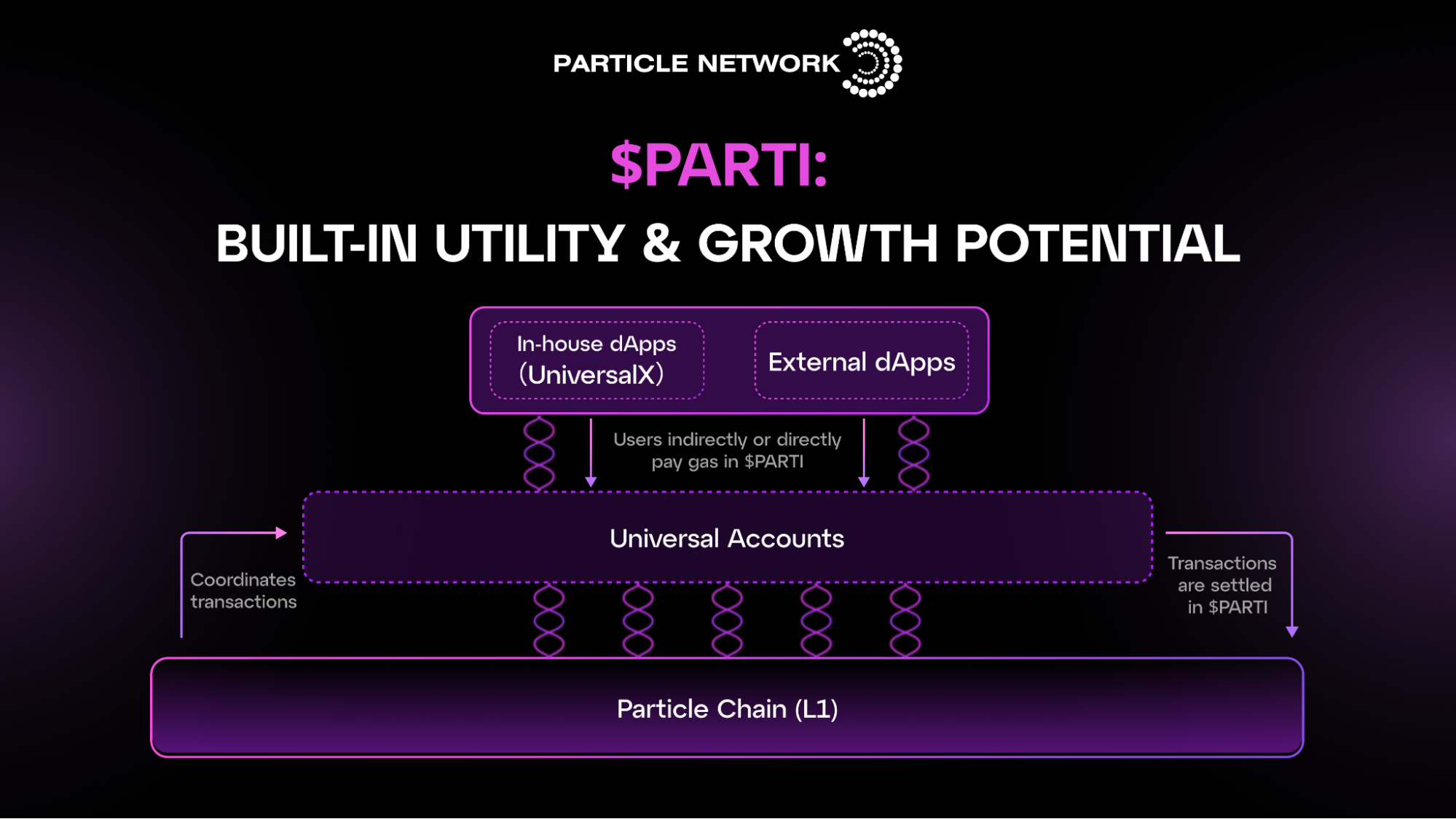
Because of the above setup, since the inception of the Particle Chain and Universal Accounts, $PARTI has been a core element within our roadmap to unify the fragmented blockchain landscape.
As Universal Accounts’ ecosystem develops and more transactions are settled by the Particle Chain, $PARTI’s built-in utility will not only capture more value, but also rapidly grow in demand within the network.
Expanding Universal Accounts’ ecosystem
Furthermore, we recently announced our roadmap to drive Web3 into the Abstraction Era in three phases:
- In Phase 1, Permissioned Ecosystem, we launch and develop Universal Accounts’ initial use cases and the infrastructure making it possible—including $PARTI and the Particle Chain.
- In Phase 2, Collaborative Ecosystem, we onboard new and existing projects to Universal Accounts, giving birth to a chain-abstracted ecosystem. At this stage, the Particle Chain will be fully public and decentralized.
- In Phase 3, Permissionless Ecosystem, any dApp—and even any chain—can seamlessly access chain abstraction by plugging into Universal Accounts and, by proxy, the Particle Chain.
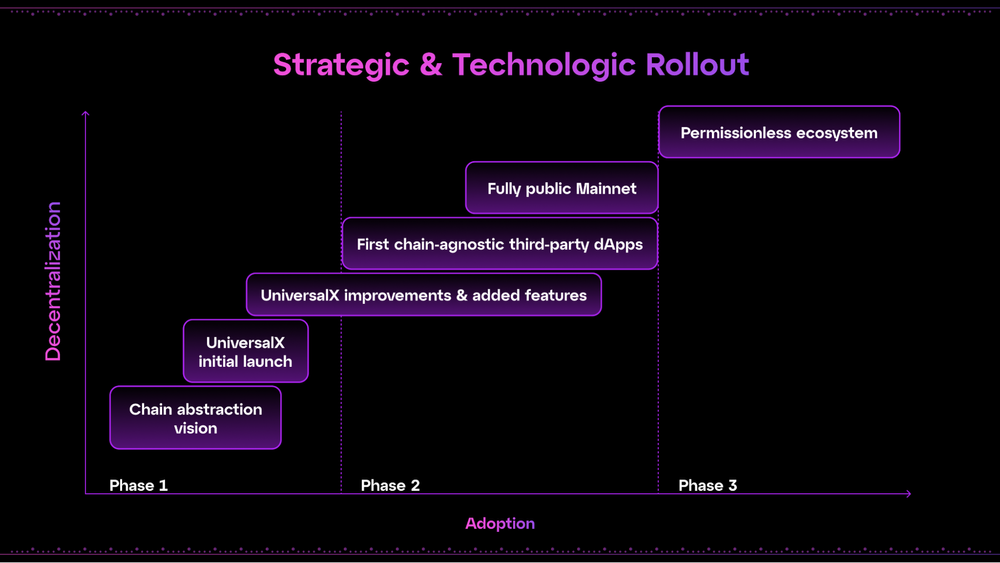
Once again, this roadmap is carefully designed around maintaining healthy economics for the network. $PARTI’s is crafted to accrue value across every layer of the technology stack—chain, infrastructure, and applications—while facilitating the unification of all chains within a rapidly-growing ecosystem. This creates a prosperous internal economy, driving usage as this value grows and vice versa.
In other words, $PARTI is a catalyst that both strengthens the technology behind the Particle Chain AND links ecosystem and economic growth.
Token Utility and Purpose
$PARTI serves several utilities, all onchain and designed to accrue value and demand as Universal Accounts’ usage grows and Particle’s ecosystem expands.
In particular, $PARTI is used within three fundamental layers:
• At a chain level. $PARTI is the Particle Chain’s gas token, as well as powering its validator ecosystem. All transactions executed by the Particle Chain are settled in $PARTI. Furthermore, to sustain the chain’s security, users can stake tokens to validators, decentralizing Particle Network.
• At an infrastructure level. $PARTI is used as an intermediary token within Universal Liquidity, working as an economic mechanism facilitating chain abstraction. Users can stake and provide $PARTI as liquidity, allowing the token to accrue value from the cross-chain transactions facilitated by Particle’s infrastructure, encompassing all operations executed by Universal Accounts.
• At an application level. $PARTI is used as a utility token within the ecosystem of applications leveraging Universal Accounts—including UniversalX—offering use cases such as transaction fee discounts, launchpool participation, IDOs, and primary token auctions.
For users, this means there is a wide variety of ways to take advantage of the $PARTI token—starting with Universal Gas and evolving as the ecosystem grows and decentralizes:
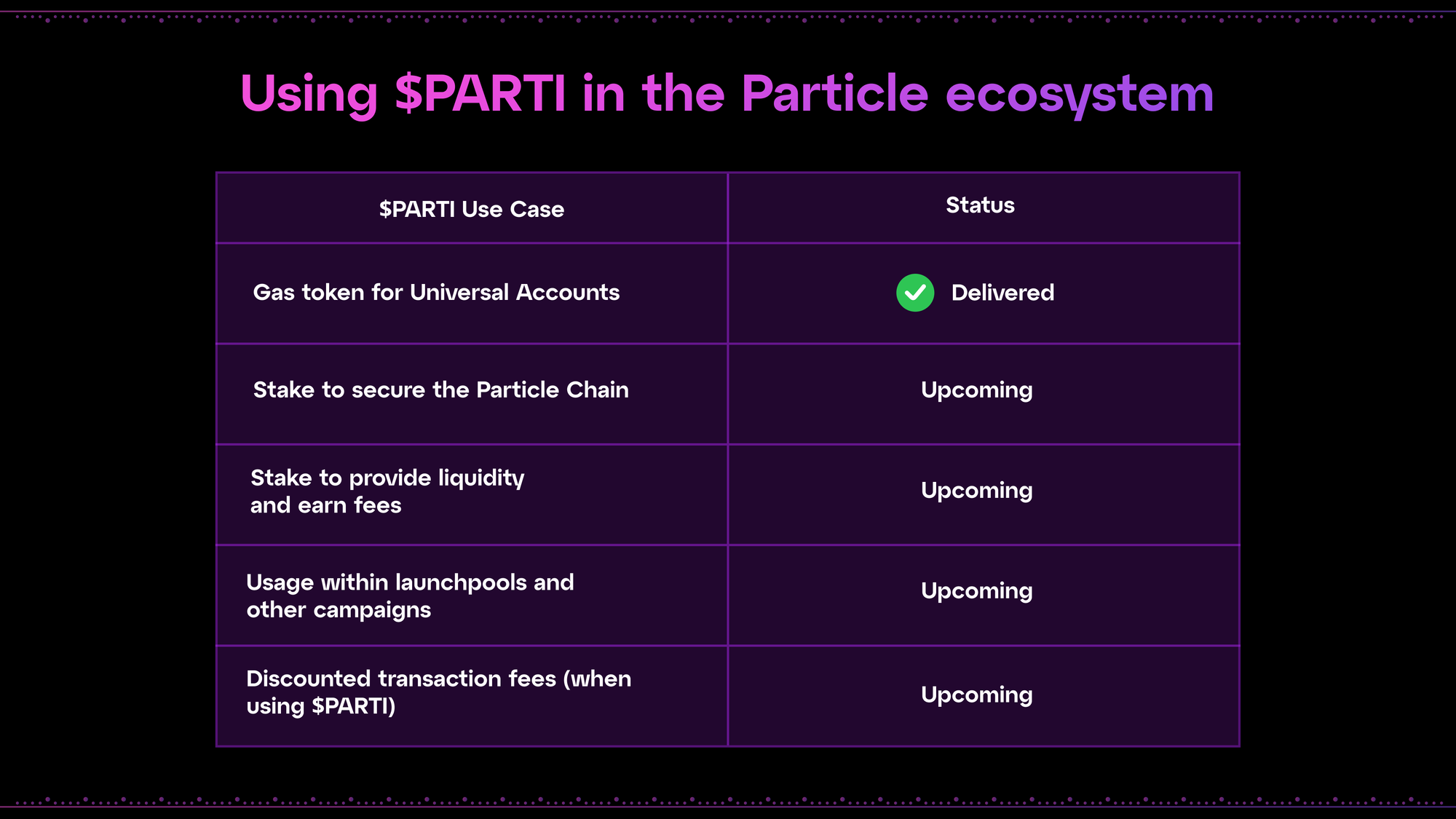
In summary, $PARTI serves as a pillar for the Particle Chain and Universal Account ecosystem, securing the network, decentralizing its ownership, facilitating its internal economy, and providing value to holders.
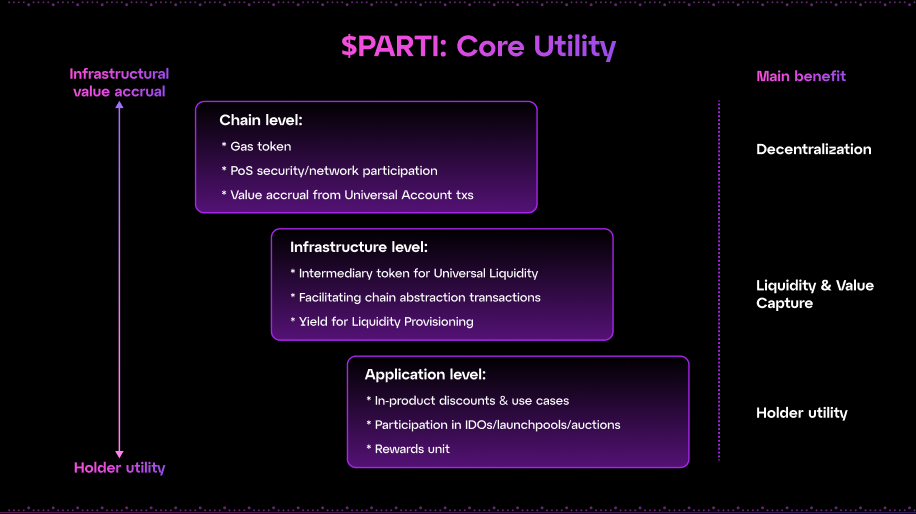
$PARTI Tokenomics
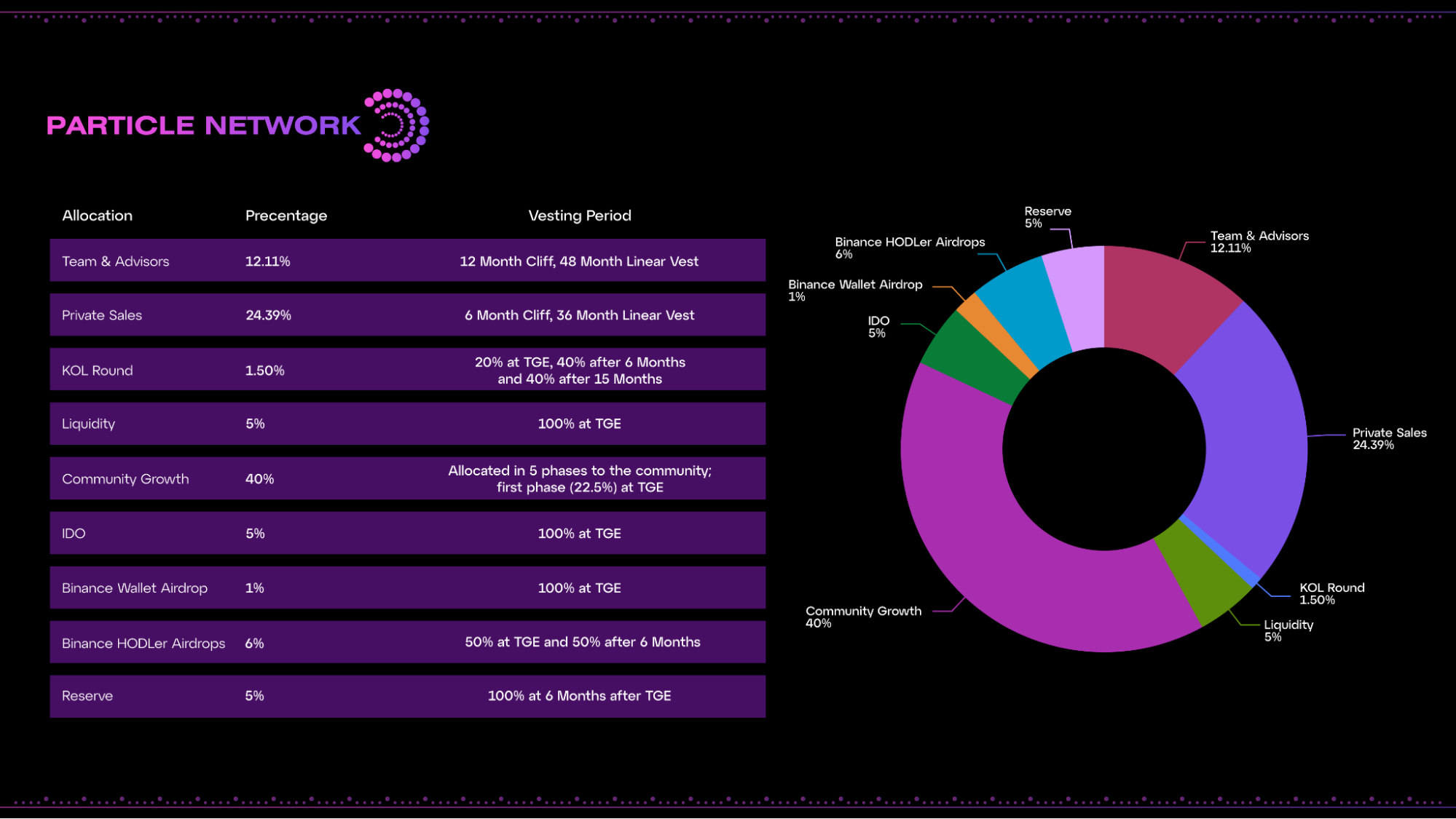
In summary, $PARTI features a fixed supply of 1,000,000,000 $PARTI tokens (with an initial circ. supply of 233M $PARTI), released gradually to avoid sudden inflation. Unallocated tokens remain locked until key ecosystem or protocol milestones are reached.
Tokens will be allocated as follows:
- Team & Advisors (12.11%): Vested over multiple years for long-term project alignment.
- Private Sales (24.39%): Locked initially, with a multi-year release schedule.
- KOL Round (1.50%): Reserved for strategic influencers and partners, partially unlocking at TGE, then gradually over time.
- Liquidity (5%): Deployed at TGE to support immediate market stability and depth.
- Community Growth (40%): Distributed in multiple phases to foster user adoption and incentivize broader engagement. This includes a total of 9% for initial airdrops, with the remaining community tokens released periodically.
- IDO (5%): $PARTI’s Binance Wallet IDO.
- Binance Wallet Airdrop (1%): Allocated at TGE for targeted user onboarding via Binance Wallet.
- Binance HODLer Airdrops (6%): Distributed to long-term BNB holders, in two separate airdrops.
- Reserve (5%): Held for future strategic needs and ecosystem expansion.
In essence, $PARTI’s tokenomics prioritize sustainable growth and stakeholder alignment. By allocating tokens to incentivize builders, maintain network security, and reward long-term commitment, the Particle ecosystem lays a strong foundation for chain-agnostic innovation.
Conclusion
$PARTI's release is a milestone for our community, project, and a cornerstone of our expansion plans. Thanks to it, we will be able to scale Universal Accounts' and the Particle Chain to achieve our vision of abstracting the entirety of Web3, taking us into the next Era of the decentralized Internet.
Whether you’re a builder, a power user, or simply exploring, $PARTI has a utility for you—and more so, for our industry’s future.
Particle Network's Chain Abstraction solutions are 100% free for developers and teams. By integrating them, you can set your project in a path to leveraging chain abstraction.
About Particle Network

Particle Network powers chain abstraction, addressing Web3's fragmentation of users and liquidity. This is enabled by Particle's Universal Accounts, which give users a unified account and balance across all chains.
Share this article
About the author(s)


